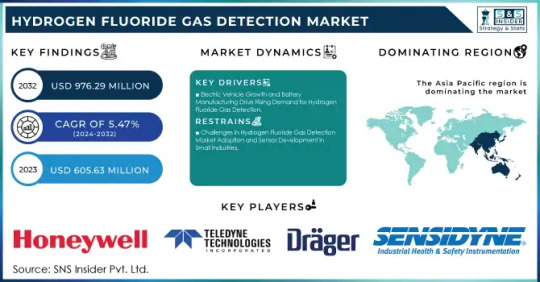#hydrogen fluoride gas detector
Explore tagged Tumblr posts
Text
Hydrogen Fluoride Gas Detection Market Growth: Key Drivers, Challenges, and Opportunities
Growing Industrial Safety Regulations Drive Demand in the Hydrogen Fluoride Gas Detection Market.

The Hydrogen Fluoride Gas Detection Market Size was valued at USD 605.63 Million in 2023 and is expected to reach USD 976.29 Million by 2032, growing at a CAGR of 5.47% over the forecast period 2024-2032.
The Hydrogen Fluoride (HF) Gas Detection Market is experiencing steady growth due to increasing industrial safety regulations, environmental concerns, and advancements in gas detection technologies. Hydrogen fluoride, a highly toxic and corrosive gas, is widely used in chemical manufacturing, petroleum refining, semiconductor production, and pharmaceuticals. Its hazardous nature has led industries to adopt advanced gas detection systems to ensure workplace safety, prevent accidental leaks, and comply with stringent government regulations.
Key Players in the Hydrogen Fluoride Gas Detection Market
Honeywell International (Portable Gas Detectors, Fixed Gas Detection Systems)
Teledyne Technologies (Multi-Gas Detectors, Personal Gas Monitors)
Drägerwerk (Toxic Gas Detectors, Personal Safety Monitors)
MSA Safety Incorporated (Portable Gas Detectors, Fixed Gas Detection Systems)
GfG Instrumentation (Gas Detection Tubes, Portable Gas Detectors)
Sensidyne (Fixed Gas Detectors, Gas Detection Tubes)
Crowcon Detection Instruments (Multi-Gas Monitors, Portable Gas Detectors)
Analytical Technology (Fixed Gas Monitors, Portable Gas Detectors)
RKI Instruments (Personal Gas Monitors, Fixed Detection Systems)
R.C. Systems (Industrial Gas Monitors, Area Gas Detection Systems)
Future Scope of the Market
The HF Gas Detection Market is set to expand due to:
Rising workplace safety regulations across industrial sectors.
Growing adoption of smart gas sensors and IoT-enabled monitoring systems.
Increased use of HF gas in the semiconductor and electronics industry.
Advancements in real-time gas detection technology with wireless and AI-based analytics.
Expanding industrialization in emerging economies driving demand for gas monitoring systems.
Emerging Trends in the Hydrogen Fluoride Gas Detection Market
With industries prioritizing worker safety and environmental protection, companies are shifting towards real-time, AI-powered, and wireless gas detection systems. The integration of Internet of Things (IoT), cloud-based monitoring, and predictive analytics is revolutionizing HF gas detection, allowing businesses to detect leaks instantly and take proactive safety measures. Furthermore, portable and wearable gas detectors are becoming more popular among industrial workers, providing on-the-go safety alerts. Regulatory compliance mandates across sectors, including chemical plants, oil & gas, and semiconductors, are also accelerating the adoption of highly sensitive and automated HF detection solutions.
Key Points:
Stringent industrial safety regulations driving demand for HF gas detection systems.
Growing use of hydrogen fluoride in semiconductor manufacturing and chemical processing.
Adoption of IoT-enabled, real-time gas monitoring solutions.
Rising demand for portable and wearable HF gas detectors.
Advancements in AI-powered gas detection analytics for predictive safety.
Conclusion
The Hydrogen Fluoride Gas Detection Market is witnessing significant growth as industries emphasize workplace safety, regulatory compliance, and advanced detection technologies. With the rise of smart, real-time gas monitoring solutions, businesses are investing in cutting-edge gas detection systems to protect workers and prevent hazardous leaks. As industrial expansion and environmental concerns continue to grow, the market is set for further advancements, ensuring safer and more efficient operations across key industries.
Read Full Report: https://www.snsinsider.com/reports/hydrogen-fluoride-gas-detection-market-1527
Contact Us:
Jagney Dave — Vice President of Client Engagement
Phone: +1–315 636 4242 (US) | +44- 20 3290 5010 (UK)
#Hydrogen Fluoride Gas Detection Market#Hydrogen Fluoride Gas Detection Market Size#Hydrogen Fluoride Gas Detection Market Share#Hydrogen Fluoride Gas Detection Market Report#Hydrogen Fluoride Gas Detection Market Forecast
0 notes
Text
iceloong r-134a Refrigerant gas
Icelong R-134a is a hydrofluorocarbon (HFC) refrigerant commonly used in various cooling and refrigeration applications. It is a popular alternative to CFC refrigerants like R-12 due to its lower environmental impact, particularly in terms of ozone depletion. Ozone Depletion Potential (ODP): 0 (R-134a does not contribute to ozone layer depletion) Global Warming Potential (GWP): 1430 (It has a GWP of 1430, meaning it has a higher potential for contributing to global warming compared to some other refrigerants) 4. Chemical Stability: Icelong R-134a is chemically stable under normal operating conditions. It does not break down easily into harmful products unless exposed to very high temperatures (e.g., fires), where it can decompose into toxic compounds such as hydrogen fluoride (HF) and carbonyl fluoride (COF2). 5. Safety and Handling: Safety Classification: ASHRAE A1, which indicates that it is non-toxic and non-flammable under normal conditions. Leak Detection: Can be detected using electronic leak detectors designed for HFC refrigerants.

#alramiz#hvac#machines#wholesale#rewinding materials#thermostat#tools & safety#heater & element#are#acsparta#IcelongR134a#R134a#Refrigerant#HFC134a#R134aRefrigerant#HVAC#AirConditioning#Refrigeration#EcoFriendlyRefrigerant#NonFlammable#OzoneSafe#GWP1430#GreenCooling#AutoAC#RefrigerantGas
0 notes
Text

#Gas detector#fixed gas detector#sewer gas detector#fixed sensor#types of gas sensors#toxic gas monitor#toxic gas detector#gas detection instruments#LEL gas detector#nitrogen gas monitor#hydrogen fluoride gas detector#hydrogen fluoride gas monitor#types of gas detector#what is a gas detector#detector gas#portable flue gas
1 note
·
View note